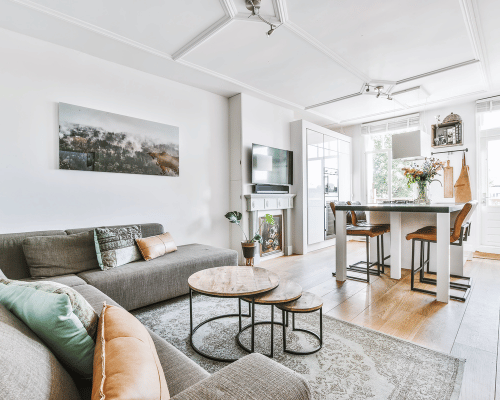In the tapestry of life, caring for a loved one with dementia is a profound and delicate task. As the number of individuals touched by this condition continues to rise, the need for tailored, heartfelt care solutions becomes ever more critical. This journey is not just about medical treatments or therapies; it's deeply personal. It's about transforming our homes into spaces of safety, comfort, and understanding, where those with dementia can feel supported and cherished. As we navigate through this guide, we'll illuminate the ways in which we can adapt our living spaces, turning them into nurturing havens that enhance the quality of life for both our loved ones and ourselves. Together, let's explore compassionate strategies to make our homes a true sanctuary for dementia care.
Dementia is more than just a single disease. It’s a collective term that describes various symptoms associated with a decline in memory, reasoning, or other thinking skills. Various forms of dementia exist, including Alzheimer's disease, which accounts for 60-80% of cases. As dementia progresses, the needs and safety of the affected individuals become paramount.
Minimize tripping risks by removing clutter and securing or removing loose rugs. Ensure that stairways have handrails and are well-lit. It’s also advisable to install grab bars in bathrooms and avoid having electrical cords running across the floor.

Hallways and rooms should have clear and direct paths. This prevents confusion and makes navigation easier for someone with dementia. Proper lighting is essential, especially during nighttime.
Familiar objects can serve as comforting reminders for dementia patients. Retaining personal items, family photos, or even their favorite chair can provide security and continuity.

Proper illumination is crucial. Bright, even lighting can prevent shadows that might confuse or scare a person with dementia. Conversely, reduce glare using curtains or blinds, as excessive glare can cause disorientation.
Noise can be distressing for people with dementia. A designated quiet area where your loved one can relax and be free from overwhelming stimuli can be beneficial.

Tailoring activities to align with the cognitive abilities and interests of individuals with dementia is crucial. Choose more straightforward tasks that mirror hobbies they once enjoyed, breaking them down into manageable steps. For example, if they love gardening, engage them in potting a plant or watering flowers. Modify board games using fewer pieces or create customized memory cards with family photos. By actively adjusting activities, we not only maintain their sense of purpose and self-worth but also stimulate cognitive function in a comforting and familiar manner.
Here are a couple of activities that can help promote engagement:
In some cases, bringing in a professional caregiver or considering day-care services for dementia patients can be beneficial. They are trained to handle specific challenges the disease poses and can introduce therapeutic activities to enhance the patient's well-being.
Several devices can aid in the care of individuals with dementia. From simple clocks displaying day and time to specialized alarms, technological solutions can enhance safety and provide caregivers with peace of mind.

Caring for someone with dementia can be challenging. But with empathy, understanding, and suitable home modifications, you can create an environment where your loved one feels safe, loved, and valued. It's not about creating a house; it's about creating a home that caters to their unique needs and ensures their well-being.
Turning homes into safe havens for dementia care requires environmental adjustments, engagement strategies, and professional interventions. By understanding the unique needs of individuals with dementia and making the necessary modifications, we can ensure a nurturing environment where they can thrive. Remember, every little effort counts, and with collective consciousness and empathy, we can bring about a positive change in the lives of those affected by dementia.
The journey through Alzheimer's or dementia is profoundly personal and varies significantly for each individual. Recognizing this diversity of experiences, BrightStar Home Care Las Vegas W adopts a flexible and responsive approach. With our nurse-led care plans at the forefront, we cater to the nuanced needs across the entire spectrum of dementia.
Adapting to evolving requirements is a hallmark of our services. As the condition progresses and needs shift, our care strategy adjusts seamlessly, ensuring continuity and consistent support.
Our driving ambition is to shoulder the challenges, providing care rooted in compassion and understanding. This allows families to focus on what truly matters: creating memorable moments and fostering deep connections with their loved ones.
At the heart of our service lies a profound respect for the individual. We take immense pride in facilitating person-centered Alzheimer’s and dementia care, championing the right of everyone in our community to live with dignity and grace within the sanctity of their homes.

The Landscape of Dementia
Dementia is more than just a single disease. It’s a collective term that describes various symptoms associated with a decline in memory, reasoning, or other thinking skills. Various forms of dementia exist, including Alzheimer's disease, which accounts for 60-80% of cases. As dementia progresses, the needs and safety of the affected individuals become paramount.
Essential Home Modifications
1. Safety First: Eliminating Potential Hazards
Minimize tripping risks by removing clutter and securing or removing loose rugs. Ensure that stairways have handrails and are well-lit. It’s also advisable to install grab bars in bathrooms and avoid having electrical cords running across the floor.
- Declutter Living Spaces: Begin by clearing any unnecessary items from walking paths. A clean and organized space reduces the chance of accidental trips or falls.
- Secure or Remove Loose Rugs: Check all the rugs in your home. If they tend to slip or bunch, either secure them with double-sided tape or consider removing them entirely.
- Install Handrails on Stairways: Ensure every staircase in your home has sturdy handrails on both sides. This provides additional support and stability for individuals navigating the stairs.
- Brighten Up Stairways and Hallways: Opt for bright, even lighting in movement areas. Properly illuminated spaces can prevent missteps and help individuals with dementia feel more confident in their surroundings.
- Equip Bathrooms with Grab Bars: Bathrooms can be especially hazardous due to wet surfaces. Place grab bars near the toilet and inside the shower or bathtub to assist with balance and prevent falls.
- Keep Electrical Cords Out of the Way: Regularly inspect the layout of your electrical cords. Make sure they aren’t stretching across walkways or under rugs. If necessary, use cord organizers or covers to keep them against walls and out of foot traffic areas.

2. Create Clear Pathways
Hallways and rooms should have clear and direct paths. This prevents confusion and makes navigation easier for someone with dementia. Proper lighting is essential, especially during nighttime.
- Organize Furniture for Easier Movement: In rooms and hallways, arrange furniture to create a straightforward and open route. This layout minimizes obstructions, allowing someone with dementia to move without hesitation or fear of bumping into things.
- Remove Unnecessary Obstacles: Survey each room for items that may impede movement, such as decorative stands or miscellaneous objects. By maintaining a minimalist approach, you reduce the likelihood of confusion or accidents.
- Ensure Even Flooring: Address any uneven flooring or abrupt transitions between rooms. Consider using flush thresholds or smooth transition strips to ensure a seamless flow from one area to another.
- Optimize Lighting in All Areas: Illuminate every corner of your living spaces, focusing primarily on areas frequently used during nighttime. Introduce additional lamps, overhead lights, or motion-sensor nightlights to guarantee that rooms are adequately lit, reducing the chances of mishaps and fostering a sense of security.
3. Personalization and Familiarity
Familiar objects can serve as comforting reminders for dementia patients. Retaining personal items, family photos, or even their favorite chair can provide security and continuity.
- Integrate Cherished Belongings: Place personal items, such as jewelry boxes, crafts, or souvenirs, in easily visible locations. These familiar objects can help dementia patients recall cherished memories, promoting comfort and emotional connection.
- Display Family Photos Strategically: Hang family portraits or arrange photo frames in commonly accessed areas like the living room or bedside table. These visual connections with family members can offer solace and a reassuring sense of belonging.
- Keep Favorite Furniture Accessible: If there's a particular chair or recliner they're fond of, ensure it remains in its usual spot. Such familiar touchpoints in their surroundings can significantly enhance their sense of security and daily routine.
- Avoid Frequent Redecorations: Resist the urge to change room setups or decor frequently. Keeping the environment consistent helps to maintain orientation and reduces potential confusion or distress.

4. Enhanced Lighting and Reduced Glare
Proper illumination is crucial. Bright, even lighting can prevent shadows that might confuse or scare a person with dementia. Conversely, reduce glare using curtains or blinds, as excessive glare can cause disorientation.
- Prioritize Even Illumination: Install bright, uniform lighting across all rooms, especially in hallways, staircases, and bathrooms. Consistent lighting eliminates unsettling shadows, which can be disorienting for individuals with dementia.
- Choose Appropriate Light Bulbs: Opt for LED or daylight bulbs that offer clear and consistent illumination without being overly harsh. These can recreate natural daylight conditions, which are often more comforting.
- Incorporate Adjustable Lighting: Consider using dimmer switches or adjustable lamps. This allows for customization based on the time of day or the specific needs of the individual, ensuring optimal visibility without over-illumination.
- Utilize Curtains and Blinds Effectively: To mitigate intense sunlight or external lights that might produce glare, equip windows with easily adjustable curtains or blinds. Choosing light-diffusing window treatments can balance natural light intake while minimizing potential glare-induced disorientation.
5. Designate a Quiet Space
Noise can be distressing for people with dementia. A designated quiet area where your loved one can relax and be free from overwhelming stimuli can be beneficial.
- Select an Ideal Location: Choose a room or corner of your home with fewer disturbances, perhaps away from the main thoroughfare or noisy areas like the kitchen or laundry room.
- Incorporate Comfortable Seating: Equip the space with plush chairs or loungers that encourage relaxation. Consider adding cushions or throws that your loved one finds particularly comforting.
- Limit Audio-Visual Distractions: Ensure the designated quiet area remains accessible from loud devices like radios, televisions, or computers. If these devices are present, equip them with headphones or keep the volume minimal.
- Incorporate Natural Elements: Introducing indoor plants or a small tabletop fountain can promote peace. These natural elements not only create a serene ambiance but also soothingly provide sensory stimulation.
- Provide Calming Accessories: Stock the area with items encouraging relaxation, such as soft blankets, gentle sensory toys, or books with beautiful imagery. This offers a multifaceted approach to calming the mind and body.

Adapting Activities to Promote Engagement
Tailoring activities to align with the cognitive abilities and interests of individuals with dementia is crucial. Choose more straightforward tasks that mirror hobbies they once enjoyed, breaking them down into manageable steps. For example, if they love gardening, engage them in potting a plant or watering flowers. Modify board games using fewer pieces or create customized memory cards with family photos. By actively adjusting activities, we not only maintain their sense of purpose and self-worth but also stimulate cognitive function in a comforting and familiar manner.
Here are a couple of activities that can help promote engagement:
- Memory Boxes and Albums: Engage your loved one in reminiscing through memory boxes filled with mementos or photo albums. This stimulates cognitive functions and provides an avenue for meaningful interactions.
- Sensory Activities: Simple activities like listening to music, gardening, or even tactile engagements with various textures can stimulate senses and offer therapeutic benefits.
- Establishing a Routine: Consistency is comforting. Setting and sticking to a daily routine can provide structure and reduce anxiety for dementia patients.
Professional Care within a Home Setting
In some cases, bringing in a professional caregiver or considering day-care services for dementia patients can be beneficial. They are trained to handle specific challenges the disease poses and can introduce therapeutic activities to enhance the patient's well-being.
Technological Solutions and Assistive Devices
Several devices can aid in the care of individuals with dementia. From simple clocks displaying day and time to specialized alarms, technological solutions can enhance safety and provide caregivers with peace of mind.
Embracing the Journey with Empathy
Caring for someone with dementia can be challenging. But with empathy, understanding, and suitable home modifications, you can create an environment where your loved one feels safe, loved, and valued. It's not about creating a house; it's about creating a home that caters to their unique needs and ensures their well-being.Turning homes into safe havens for dementia care requires environmental adjustments, engagement strategies, and professional interventions. By understanding the unique needs of individuals with dementia and making the necessary modifications, we can ensure a nurturing environment where they can thrive. Remember, every little effort counts, and with collective consciousness and empathy, we can bring about a positive change in the lives of those affected by dementia.
Understanding Individual Needs: The Core of Our Commitment
The journey through Alzheimer's or dementia is profoundly personal and varies significantly for each individual. Recognizing this diversity of experiences, BrightStar Home Care Las Vegas W adopts a flexible and responsive approach. With our nurse-led care plans at the forefront, we cater to the nuanced needs across the entire spectrum of dementia.Adapting to evolving requirements is a hallmark of our services. As the condition progresses and needs shift, our care strategy adjusts seamlessly, ensuring continuity and consistent support.
Our driving ambition is to shoulder the challenges, providing care rooted in compassion and understanding. This allows families to focus on what truly matters: creating memorable moments and fostering deep connections with their loved ones.
At the heart of our service lies a profound respect for the individual. We take immense pride in facilitating person-centered Alzheimer’s and dementia care, championing the right of everyone in our community to live with dignity and grace within the sanctity of their homes.


